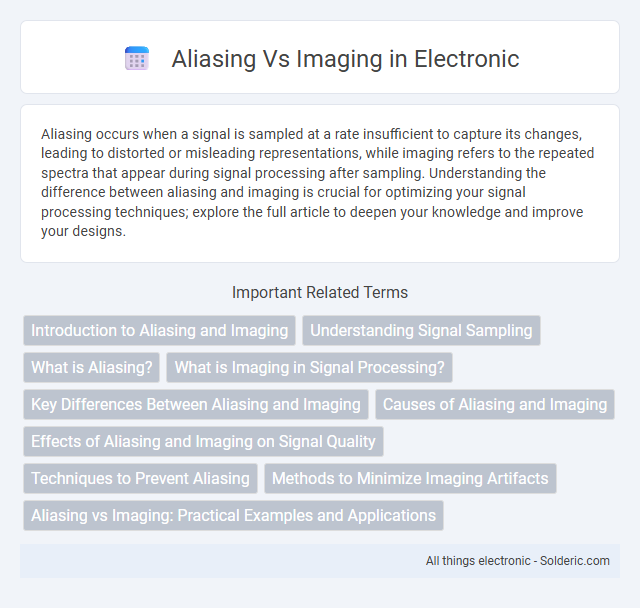Aliasing occurs when a signal is sampled at a rate insufficient to capture its changes, leading to distorted or misleading representations, while imaging refers to the repeated spectra that appear during signal processing after sampling. Understanding the difference between aliasing and imaging is crucial for optimizing your signal processing techniques; explore the full article to deepen your knowledge and improve your designs.
Comparison Table
| Aspect | Aliasing | Imaging |
|---|---|---|
| Definition | Distortion that occurs when a signal is undersampled, causing overlapping of frequency components. | Creation of mirror copies of a signal spectrum due to sampling beyond Nyquist frequency. |
| Cause | Sampling frequency below twice the highest signal frequency (Nyquist rate). | Sampling process producing replicas of the original signal spectrum at multiples of the sampling frequency. |
| Effect | Signal distortion and loss of information. | Additional spectral components appearing at image frequencies. |
| Mitigation | Use of anti-aliasing filters; proper sampling rate (>= Nyquist rate). | Use of image-reject filters; careful system design to suppress unwanted spectral copies. |
| Field of Use | Analog-to-digital conversion, signal sampling. | Radio frequency systems, mixers, and sampling in communication systems. |
| Key Parameter | Sampling frequency and signal bandwidth relation. | Sampling frequency and filter design for image rejection. |
Introduction to Aliasing and Imaging
Aliasing occurs when a signal is sampled below its Nyquist rate, causing different frequency components to become indistinguishable and resulting in distortion. Imaging refers to the unwanted high-frequency replicas generated by sampling, which appear as mirror images of the original signal spectrum. Both phenomena significantly impact digital signal processing accuracy and must be addressed through proper sampling and filtering techniques.
Understanding Signal Sampling
Aliasing occurs when a continuous signal is undersampled below its Nyquist frequency, causing different signal frequencies to become indistinguishable and resulting in distortion. Imaging arises during the reconstruction process when the sampled signal generates unwanted replicas at multiples of the sampling frequency, impacting signal quality. Understanding these phenomena is crucial for optimizing your signal sampling strategy to ensure accurate digital representation of analog signals.
What is Aliasing?
Aliasing occurs when a continuous signal is sampled below its Nyquist rate, causing different frequency components to become indistinguishable in the sampled data. This phenomenon leads to distortion where high-frequency signals are misrepresented as lower frequencies, affecting digital signal processing accuracy. Effective anti-aliasing filters are crucial to prevent aliasing by limiting the signal bandwidth before analog-to-digital conversion.
What is Imaging in Signal Processing?
Imaging in signal processing refers to the distortion that occurs when a signal is sampled and frequency components from one part of the spectrum are reflected or mirrored into another, typically resulting from improper filtering before analog-to-digital conversion. This phenomenon often leads to unwanted frequency replicas, degrading signal quality and accuracy. Understanding imaging helps optimize your sampling strategy and anti-aliasing filter design to preserve signal integrity.
Key Differences Between Aliasing and Imaging
Aliasing occurs when a continuous signal is undersampled, causing different signals to become indistinguishable, leading to distortion or artifacts in the reconstructed signal. Imaging arises from improper filtering in sampling, where unwanted spectral replicas appear in the sampled data, causing overlap and interference. The key difference lies in aliasing resulting from inadequate sampling rates violating the Nyquist criterion, while imaging stems from insufficient anti-imaging filters failing to remove spectral replicas after sampling.
Causes of Aliasing and Imaging
Aliasing occurs when a signal is sampled below its Nyquist rate, causing different frequency components to become indistinguishable and resulting in distortion. Imaging happens due to the presence of images or mirror frequencies created by the sampling process, typically when the analog signal is not properly band-limited before sampling. Both phenomena arise from inadequate sampling techniques and insufficient anti-aliasing filters, leading to overlapping spectral components in the sampled signal.
Effects of Aliasing and Imaging on Signal Quality
Aliasing causes distortion in signal quality by introducing spurious frequency components that overlap with the original signal spectrum, resulting in inaccurate signal representation. Imaging leads to unwanted frequency replicas that appear due to imperfect filtering of sampled signals, degrading the fidelity of the reconstructed signal. Both effects compromise signal integrity, with aliasing primarily affecting signal analysis and imaging impacting signal reconstruction in digital systems.
Techniques to Prevent Aliasing
Techniques to prevent aliasing primarily involve increasing the sampling rate beyond the Nyquist frequency, ensuring accurate signal representation without frequency overlap. Employing anti-aliasing filters, typically low-pass filters, effectively attenuates frequencies above half the sampling rate before analog-to-digital conversion. Oversampling combined with digital signal processing algorithms further refines signal fidelity, minimizing the risk of aliasing artifacts in digital systems.
Methods to Minimize Imaging Artifacts
To minimize imaging artifacts caused by aliasing, implementing anti-aliasing filters before sampling effectively limits the signal bandwidth to half the sampling frequency. Increasing the sampling rate above the Nyquist frequency ensures accurate signal representation, reducing the risk of overlap between spectral replicas. Employing oversampling combined with digital signal processing techniques further enhances artifact suppression and image clarity.
Aliasing vs Imaging: Practical Examples and Applications
Aliasing occurs when a signal is undersampled, causing different signals to become indistinguishable, while imaging happens due to insufficient filtering in sampled systems, producing mirrored frequency components. In practical applications like digital audio recording, aliasing can distort sound quality if the sampling rate is too low, whereas imaging artifacts appear in MRI scans if anti-aliasing filters are not applied effectively. Your ability to mitigate aliasing and imaging effects depends on choosing proper sampling rates and filter designs tailored to your specific signal processing needs.
Aliasing vs imaging Infographic

 solderic.com
solderic.com